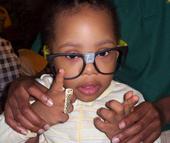.. ..
Goto Downsyndrome chat group Get a Chat Box
I'd like to meet:
The opportunities currently available to individuals with Down syndrome have never been greater. However, it is only through the collective efforts of parents, professionals, and concerned citizens that acceptance is becoming even more widespread. It is the mission of the National Down Syndrome Society to ensure that all people with Down syndrome are provided the opportunity to achieve their full potential in all aspects of their lives.
The Causes of Down Syndrome:The human body is made of cells. All cells contain a center, called a nucleus, in which genes are stored. Genes, which carry the codes responsible for all our inherited characteristics, are grouped along rod-like structures called chromosomes. Normally, the nucleus of each cell contains 23 pairs of chromosomes, half of which are inherited from each parent. Down syndrome occurs when some or all of a person’s cells have an extra full or partial copy of chromosome 21.
The most common form of Down syndrome is known as Trisomy 21. Individuals with Trisomy 21 have 47 chromosomes instead of the usual 46 in each of their cells. The condition results from an error in cell division called nondisjunction. Prior to or at conception, a pair of 21st chromosomes in either the sperm or the egg fails to separate. As the embryo develops, the extra chromosome is replicated in every cell of the body. This error in cell division is responsible for 95 percent of all cases of Down syndrome.
The cause of the extra full or partial chromosome is still unknown. What we do know that it is not caused by environmental factors or anything the mother does before or during her pregnancy. Maternal age is the only factor that has been linked to an increased chance of having a baby with Down syndrome resulting from nondisjunction. A 35-year-old woman has a one in 350 chance of conceiving a child with Down syndrome. By age 45, the incidence has increased to one in 30. However, because younger women have higher fertility rates, 80 percent of babies with Down syndrome are born to women under the age of 35. Once a woman has given birth to a baby with Down syndrome, the chance of having a second child with Down syndrome is about 1 in 100, although age may also be a factor.
Maternal age, however, is not linked to the chance of having a baby with translocation. Most cases are sporadic, chance events, but in about one third of translocation cases, one parent is a carrier of a translocated chromosome. For this reason, the chance of translocation in a second pregnancy is higher than that seen in nondisjunction.
Movies:
NBC's Story on Christopher Scott
Sport!
Television:
Children Learn What They Live
By Dorothy Law Nolte, Ph.D.
If children live with criticism, they learn to condemn.
If children live with hostility, they learn to fight.
If children live with fear, they learn to be apprehensive.
If children live with pity, they learn to feel sorry for themselves.
If children live with ridicule, they learn to feel shy.
If children live with jealousy, they learn to feel envy.
If children live with shame, they learn to feel guilty.
If children live with encouragement, they learn confidence.
If children live with tolerance, they learn patience.
If children live with praise, they learn appreciation.
If children live with acceptance, they learn to love.
If children live with approval, they learn to like themselves.
If children live with recognition, they learn it is good to have a goal.
If children live with sharing, they learn generosity.
If children live with honesty, they learn truthfulness.
If children live with fairness, they learn justice.
If children live with kindness and consideration, they learn respect.
If children live with security, they learn to have faith in themselves and in those about them.
If children live with friendliness, they learn the world is a nice place in which to live.
Copyright © 1972 by Dorothy Law Nolte
Books:
ELMO'S REMIX
.. ..
